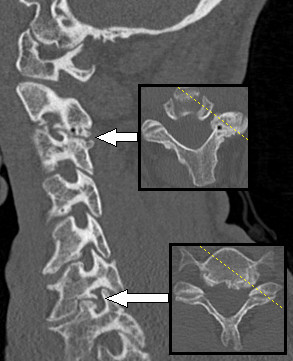Pathophysiology
- Compression of cervical nerve root resulting in radicular pain along the corresponding dermatome in the upper limb
- Causes: Degenerative changes including cervical disc herniation or spondylosis
- C7 is the most common nerve root, then C6.
Clinical Features
- Neck pain
- Pain along the corresponding dermatome in the arm, often shooting or burning
- Night pain
- Sensory symptoms - paraesthesia, loss or reduced sensation along affected dermatome
- Motor symptoms - weakness
- Examination
- Restricted neck movements
- C6 nerve root
- Weakness in elbow flexion and wrist extension
- Reflexes: Biceps and supinator affected
- Sensory changes: Along lateral forearm, thumb and first finger
- C7 nerve root
- Weakness in elbow extension, wrist flexion and finger extension
- Reflexes: Triceps reflex affected
- Sensory changes: Middle finger
- Spurling's test positive:
- Also known as a maximal cervical compression, Spurling's test involves:
- Extending the neck
- Tilting and rotating the head to the affected side
- Gently applying pressure to the head and neck
- The test is considered positive if it reproduces radiculopathic pain, weakness or sensory changes.
- Also known as a maximal cervical compression, Spurling's test involves:
Management
- If red flags are present, or there is severe progressive neurology, seek immediate specialist advice
- If cervical radiculopathy has been present for < 4-6 weeks and there are no neurological signs on examination - conservative management, including simple analgesia. Consider neuropathic analgesia if required.
- If cervical radiculopathy has been present for > 4-6 weeks or in the presence of objective neurological findings on examination:
- Perform MRI imaging to confirm the diagnosis
- Refer for consideration of spinal injections / surgery (indicated if progressive motor weakness/unremitting pain despite 6-12 weeks of conservative management), where MRI confirms compression.

References:
NICE CKS. Neck Pain - Cervical Radiculopathy [November 2023]. Available here.
